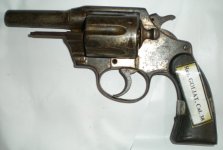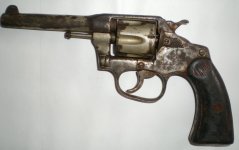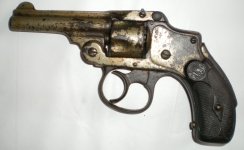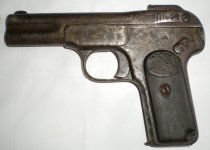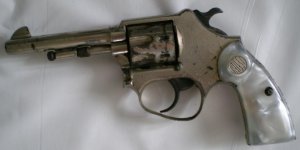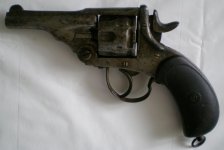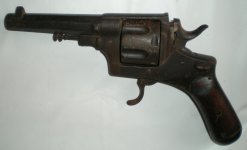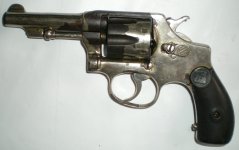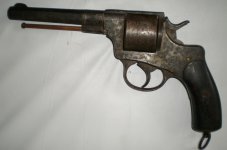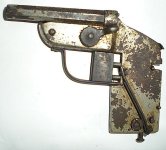Jim Watson
New member
I think No 47 is a COPY of a Smith and Wesson Hand Ejector revolver, probably from Spain. A real S&W has the trigger guard integral with the frame, this gun has pin holes to retain a separate trigger guard which is missing here. Perhaps it came from the same Bubba as the little Beretta. The hammer pivot below the latch to swing out the cylinder is not a screw on a real S&W. The hammer is not quite the right shape. The pearl handles appear to have a S&W monogram medallion but they do not fit properly and are not likely original to the gun.
The second digit in the label is not readable. It might be caliber .38, there is a black powder .38 cartridge that is the Spanish equivalent of the old .38 Long Colt. It might be recent enough to be a .38 Special.
It might be caliber .32 which could be the .32 Winchester Center Fire also known as .32-20, that was a popular cartridge in Spanish copies. I am sorry there are so many "mights" but that is all I can tell.
No 52 is a Colt model of 1903 Pocket Hammerless in caliber .32 ACP = 7.65mm Browning. The serial number is legible, it was made in late 1919.
Condition is better than most guns in the collection, it still has its magazine, and it is still a desirable firearm in the USA.
No 55 is what remains of a nearly destroyed Remington Model 51 pistol made from 1918 til 1934. Caliber is (was) probably .380 ACP = 9mm Browning Short. They made some in .32 ACP but they are much less common. In that condition, it hardly matters.
The second digit in the label is not readable. It might be caliber .38, there is a black powder .38 cartridge that is the Spanish equivalent of the old .38 Long Colt. It might be recent enough to be a .38 Special.
It might be caliber .32 which could be the .32 Winchester Center Fire also known as .32-20, that was a popular cartridge in Spanish copies. I am sorry there are so many "mights" but that is all I can tell.
No 52 is a Colt model of 1903 Pocket Hammerless in caliber .32 ACP = 7.65mm Browning. The serial number is legible, it was made in late 1919.
Condition is better than most guns in the collection, it still has its magazine, and it is still a desirable firearm in the USA.
No 55 is what remains of a nearly destroyed Remington Model 51 pistol made from 1918 til 1934. Caliber is (was) probably .380 ACP = 9mm Browning Short. They made some in .32 ACP but they are much less common. In that condition, it hardly matters.

